fuel cap BUICK REGAL 1996 Owners Manual
[x] Cancel search | Manufacturer: BUICK, Model Year: 1996, Model line: REGAL, Model: BUICK REGAL 1996Pages: 356, PDF Size: 17.97 MB
Page 119 of 356
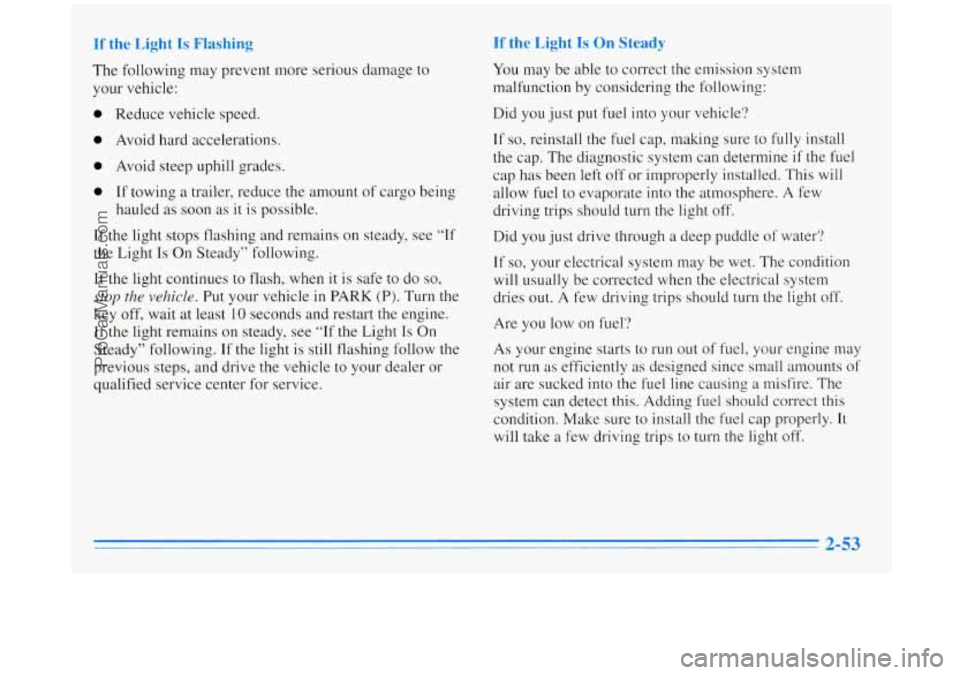
If the Light Is Flashing If the Light Is On Steady
The following may prevent more serious damage to
your vehicle:
0 Reduce vehicle speed.
0 Avoid hard accelerations.
0 Avoid steep uphill grades.
0 If towing a trailer, reduce the amount of cargo being
hauled
as soon as it is possible.
If the light stops flashing and remains on steady, see
“If
the Light Is On Steady” following.
If the light continues to flash, when it is safe to do so,
stop the vehicle. Put your vehicle in PARK (P). Turn the
key off, wait at least 10 seconds and restart
the engine.
If
the light remains on steady, see “If the Light Is On
Steady” following. If the light is still flashing follow the
previous steps, and drive the vehicle to your dealer or
qualified service center for service. You
may be able to correct the emission system
malfunction by considering the following:
Did you just put fuel into your vehicle?
If
so, reinstall the fuel cap, making sure to fully install
the cap. The diagnostic system can determine
if the fuel
cap has been left off or improperly installed. This will
allow fuel to evaporate into the atmosphere. A few
driving trips should turn the light off.
Did you just drive through a deep puddle
of water?
Tf so, your electrical system may be wet. The condition
will usually be corrected when the electrical system
dries
out. A few driving trips should turn the light off.
Are you low on fuel?
As your engine starts to run out of fuel, your engine may
not run
as efficiently as designed since small amounts of
air are sucked into the fuel line causing a misfire.
The
system can detect this. Adding fuel should correct this
condition. Make sure to install
the fuel cap properly. It
will take a few driving trips
to turn the light off.
ProCarManuals.com
Page 123 of 356
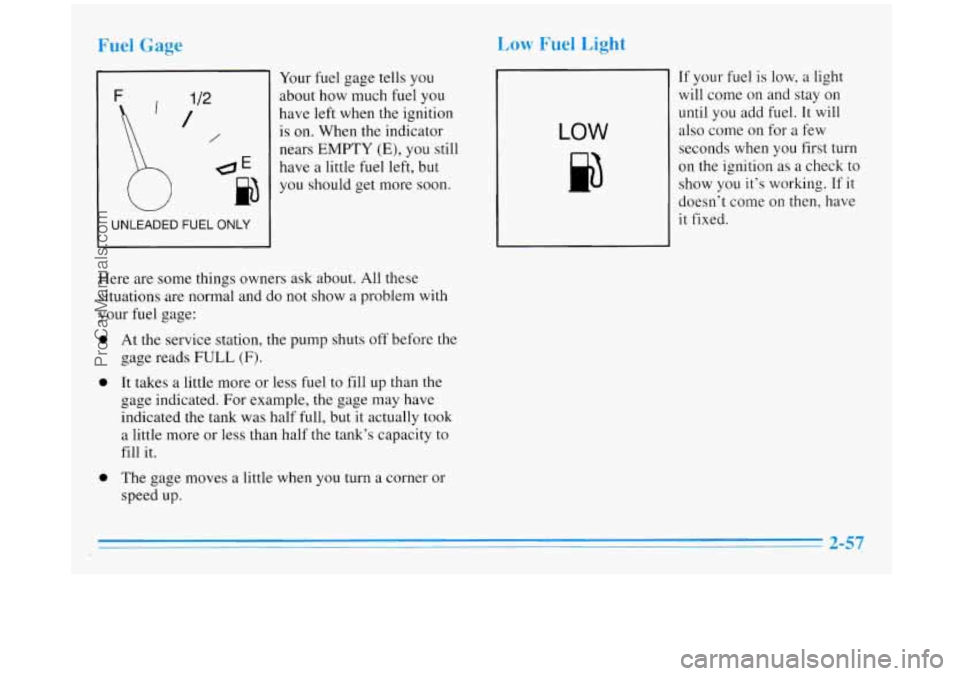
Fuel Gage
F
L
UNLEADED FUEL ONL’
1
Your fuel gage tells you
about how much fuel you
have
left when the ignition
is on. When the indicator
- nears EMPTY (E), you still
1 have a little fuel left, but
b
you should get more soon.
Here are some things owners ask about. All these
situations are normal and do not show a problem with
your
fuel gage:
0
0
0
At the service station, the pump shuts off before the
gage reads
FULL (F).
It takes a little more or less fuel to fill up than the
gage indicated. For example, the gage may have
indicated the tank was half full, but it actually took
a little more or less than half the tank’s capacity to
fill it.
The gage moves a little when
you turn a corner or
speed up.
Low Fuel Light
LOW
If your fuel is low, a light
will come on and stay on
until you add fuel. It will
also come on for
a few
seconds when
you first turn
on the ignition as a check to
show you it’s working. If it
doesn’t come on then, have
it fixed.
ProCarManuals.com
Page 127 of 356
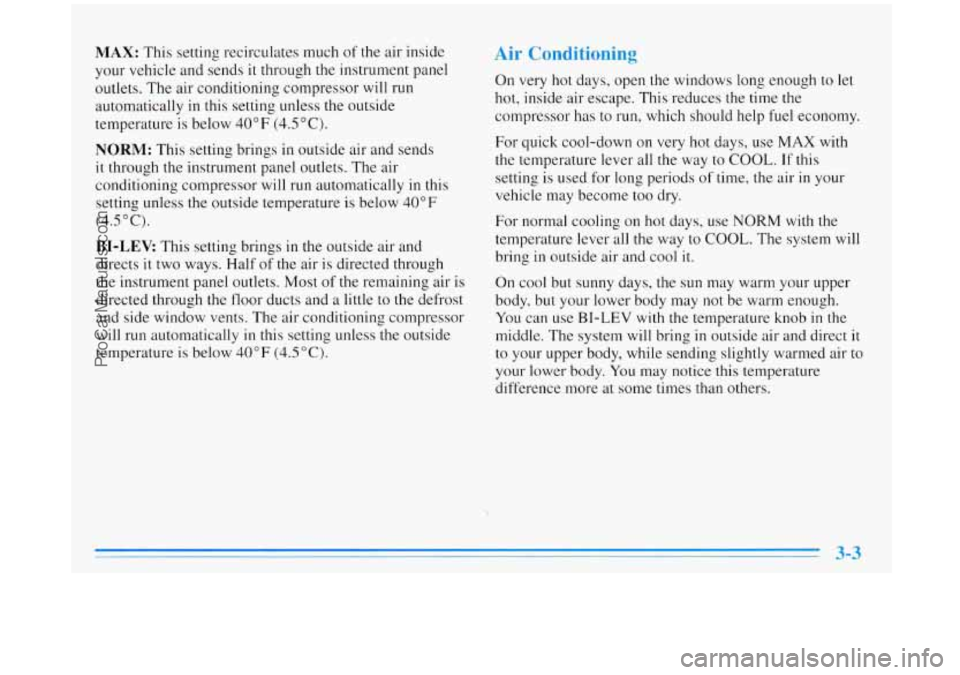
MAX: This setting recirculates much of the air inside
your vehicle and sends it through
the instrument panel
outlets. The air conditioning compressor will run
automatically
in this setting unless the outside
temperature is below 40°F (4.5"C).
NORM: This setting brings in outside air and sends
it through the instrument panel outlets. The air
conditioning compressor will run automatically
in this
setting unless the outside temperature is below 40°F
(4.5 " C).
BI-LEV: This setting brings in the outside air and
directs
it two ways. Half of the air is directed through
the instrument panel outlets. Most
of the remaining air is
directed through the floor ducts and
a little to the defrost
and side window vents. The air conditioning compressor
will run automatically in this setting unless the outside
temperature
is below 40°F (4.5"C).
Air Conditioning
On very hot days, open the windows long enough to let
hot, inside air escape. This reduces the time the
compressor has to
run, which should help fuel economy.
For quick cool-down on very hot days, use
MAX with
the temperature lever all the way to COOL.
If this
setting is used for long periods of time,
the air in your
vehicle may become too dry.
For normal cooling on hot days, use
NORM with the
temperature lever all the way to COOL. The system will
bring
in outside air and cool it.
On cool but sunny days, the sun may warm your upper
body, but your lower body may not be warm enough.
You can use BI-LEV with the temperature knob in the
middle. The system will bring
in outside air and direct it
to your upper body, while sending slightly warmed air to
your lower body. You may notice this temperature
difference more at some times than others.
3-3
ProCarManuals.com
Page 179 of 356
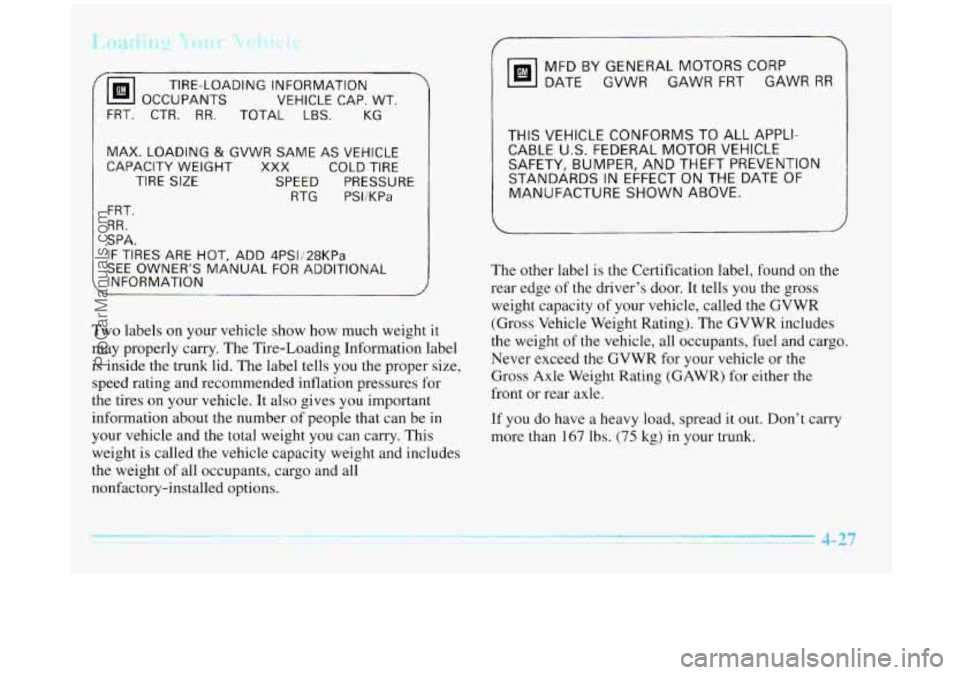
OCCUPANTS VEHICLE CAP. WT.
TIRE-LOADING INFORMATION
FRT. CTR.
RR. TOTAL LBS.
KG
MAX. LOADING
& GVWR SAME AS VEHICLE
CAPACITY WEIGHT XXX COLD TIRE
TIRE
SIZE SPEED PRESSURE
RTG
PSliKPa
FRT.
RR.
SPA.
IF TIRES ARE HOT, ADD 4PSIi28KPa
SEE OWNER‘S MANUAL FOR ADDITIONAL
. INFORMATION MFDBYGENERALMOTORSCORP
DATE GVWR GAWR FRT
GAWR RR
THIS VEHICLE CONFORMS TO ALL APPLI-
CABLE
U.S. FEDERAL MOTOR VEHICLE
SAFETY, BUMPER, AND THEFT PREVENTION
STANDARDS IN EFFECT ON
THE DATE OF
MANUFACTURE SHOWN ABOVE.
The other label is the Certification label, found on the
rear edge
of the driver’s door. It tells you the gross
weight capacity
of your vehicle, called the GVWR
Two labels on your vehicle show how much weight it
may properly carry.
The Tire-Loading Information label
is inside the trunk lid. The label tells
you the proper size,
speed rating and recommended inflation pressures for
the tires on your vehicle. It also gives you important
information about the number
of people that can be in If you do have a heavy load, spread it out. Don’t carry
your vehicle and the total weight you can carry. This more than
167 ibs. (75 kg) in your trunk.
weight is called the vehicle capacity weight and includes
the weight
of all occupants, cargo and all
nonfactory-installed options. (Gross
Vehicle Weight Rating). The GVWR includes
the weight of the vehicle, all occupants, fuel and cargo.
Never exceed the GVWR for your vehicle or the
Gross Axle Weight Rating (GAWR) for either the
front or rear axle.
4-27
ProCarManuals.com
Page 181 of 356

Towing a Trailer
A CAUTION:
If you don’t use the correct equipment and drive
properly, you can lose control when you pull
a
trailer. For example, if the trailer is too heavy, the
brakes may not work well
-- or even at all. You
and your passengers could be seriously injured.
Pull
a trailer only if you have followed all the
steps in this section. Ask your Buick dealer for
advice and information about towing
a trailer
with your vehicle.
NOTICE:
Pulling a trailer improperly can damage your
vehicle and result in costly repairs not covered by
your warranty.
To pull a trailer correctly, follow
the advice in this part, and see your Buick dealer
for important information about towing a trailer
with your vehicle.
Your vehicle can tow a trailer. To identify what the
vehicle trailering capacity is for your vehicle, you
should read the information in “Weight of the Trailer”
that appears later
in this section. But trailering is
different than just driving your vehicle by itself.
Trailering means changes in handling, durability, and
fuel economy. Successful, safe trailering takes correct
equipment, and
it has to be used properly.
4-29
ProCarManuals.com
Page 227 of 356
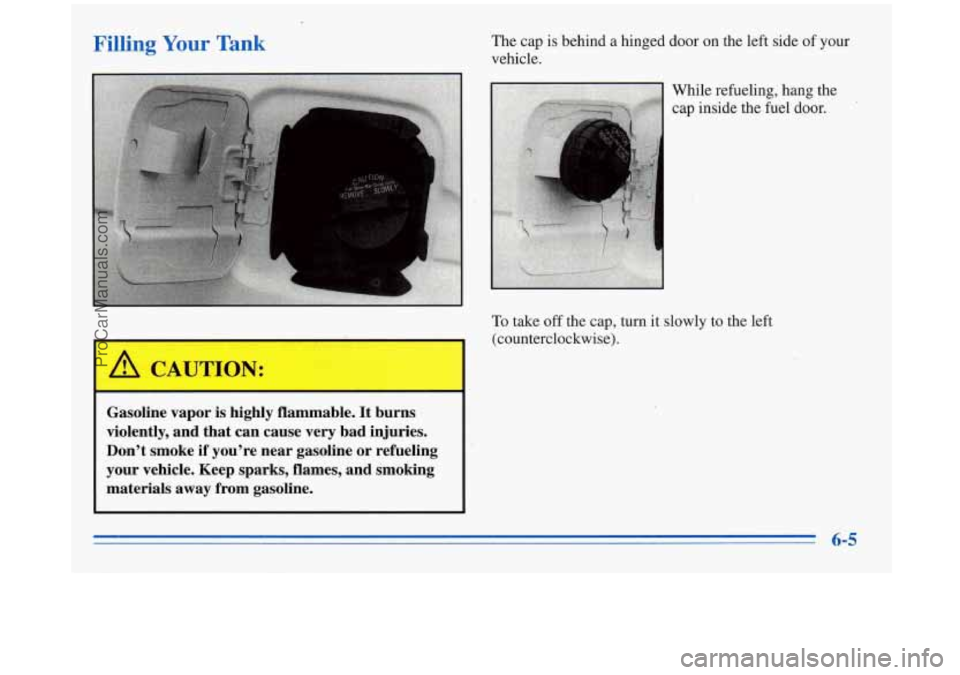
Filling Your Tank The cap is behind a hinged door on the left side of your
vehicle.
/?i CAUTION:
Gasoline vapor is highly flammable. It burns
violently, and that can cause very bad injuries.
Don’t smoke if you’re near gasoline or refueling
your vehicle. Keep sparks, flames, and smoking materials away from gasoline.
While refueling, hang the
cap inside the fuel
door.
To take off the cap, turn it slowly to the left
(counterclockwise).
6-5
ProCarManuals.com
Page 228 of 356
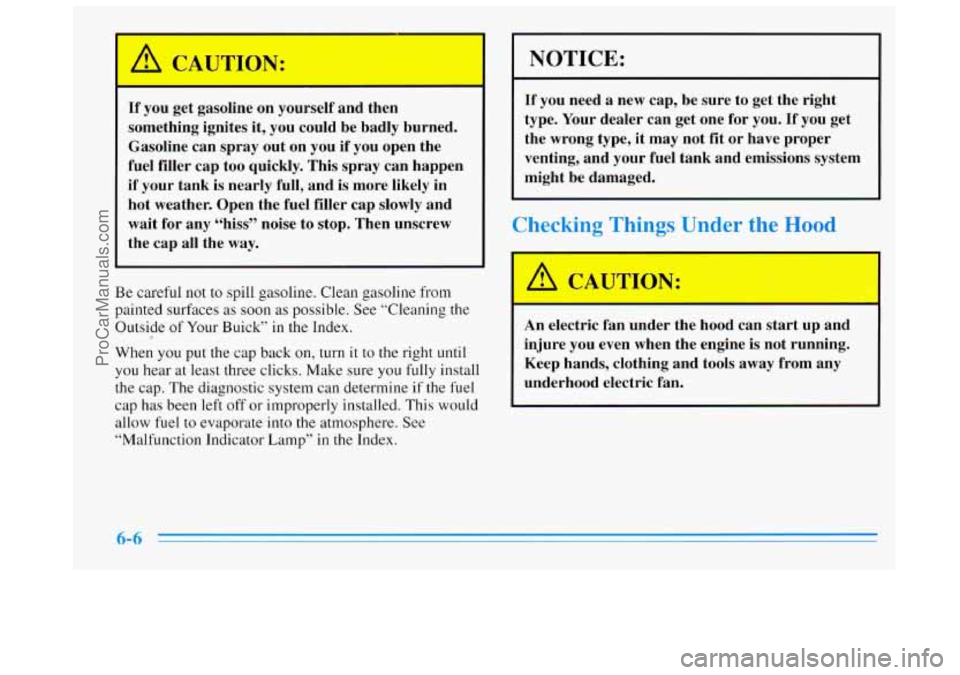
CAUTION:
If you get gasoline on yourself and then
something ignites it, you could be badly burned.
Gasoline can spray out on you if
you open the
fuel filler cap too quickly. This spray can happen
if your tank is nearly full, and
is more likely in
hot weather. Open the fuel filler cap slowly and
wait
for any “hiss” noise to stop. Then unscrew
the cap all the way.
Be careful not to spill gasoline. Clean gasoline
from
painted surfaces as soon as possible. See “Cleaning the
Outside
of Your Buick” in the Index.
When you put the cap back on, turn
it to the right until
you hear at least three clicks. Make sure you
fully install
the cap. The diagnostic system can determine if the fuel
cap
has been left off or improperly installed. This would
allow fuel
to evaporate into the atmosphere. See
“Malfunction Indicator Lamp”
in the Index.
NOTICE:
If you need a new cap, be sure to get the right
type. Your dealer can get one for you.
If you get
the wrong type, it may not fit
or have proper
venting, and your fuel tank and emissions system
might be damaged.
Checking Things Under the Hood
A CAUl iON:
An electric fan under the hood can start up and
injure you even when the engine
is not running.
Keep hands, clothing and tools away from any
underhood electric fan.
ProCarManuals.com
Page 232 of 356
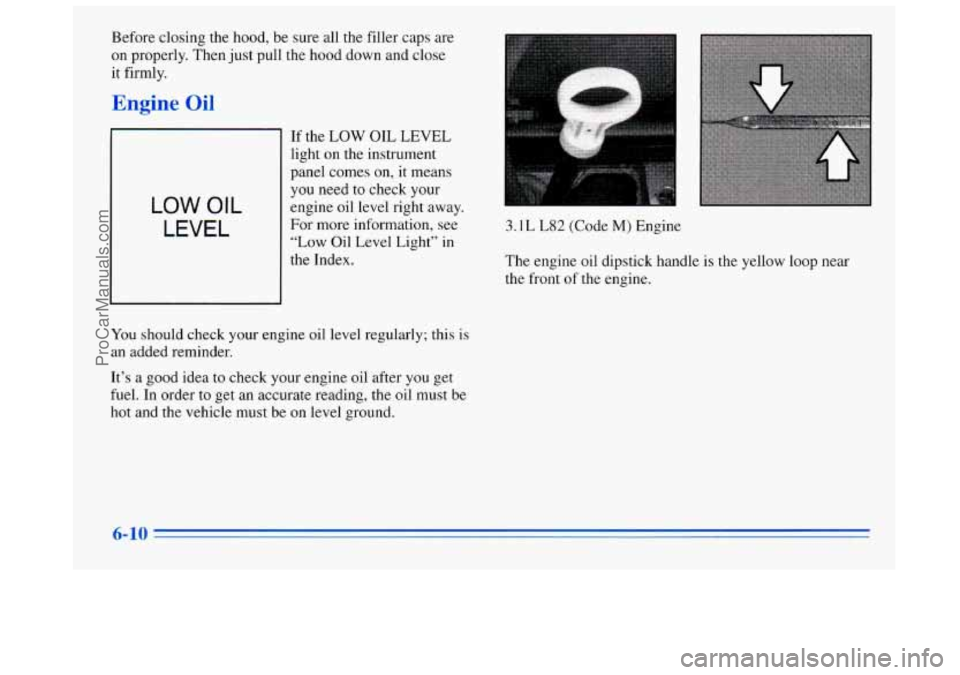
Before closing the hood, be sure all the filler caps are
on properly. Then just pull the hood down and close
it firmly.
hgine
If the LOW OIL LEVEL
light on the instrument
panel comes on, it means
you need to check your
engine oil
level right away.
For more information, see
“Low Oil Level Light” in
LOW OIL
LEVEL
the Index.
You should check your engine oil level regularly; this is
an added reminder.
It’s a good idea to check your engine oil after you get
fuel. In order to get an accurate reading, the oil must be
hot and the vehicle must be on level ground. 3.1L
LS2 (Code
M) Engine
The engine oil dipstick handle is the yellow loop near
the front
of the engine.
6-10
ProCarManuals.com
Page 283 of 356
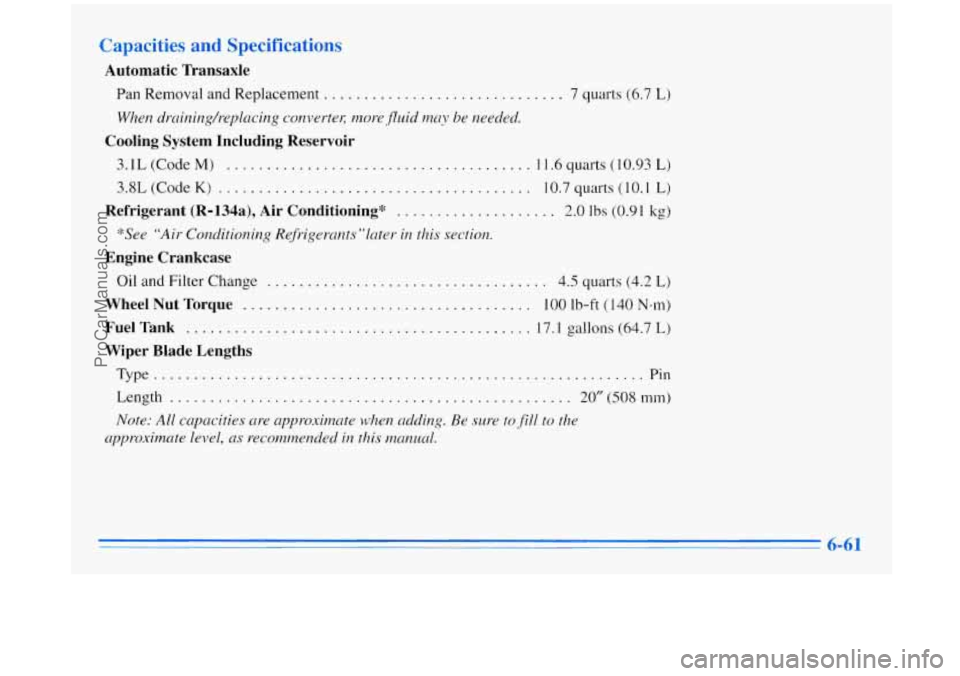
Capacities and Specifications
Automatic Transaxle
Pan Removal and Replacement .............................. 7 quarts (6.7 L)
When draiizilzg/replacil.Ig convertec more,fluid may be needed.
Cooling System Including Reservoir
3.1L(CodeM) ...................................... 11.6quarts(10.93L)
3.8L (Code
K) ....................................... 10.7 quarts (10.1 L)
Refrigerant (R-l34a), Air Conditioning* .................... 2.0 lbs (0.91 kg)
*See “Air Conditioning Refriger~-lnts”l~~tel- in th,is section.
Engine Crankcase
Oil and Filter Change ................................... 4.5 quarts (4.2 L)
Wheel Nut Torque .................................... 100 Ib-ft (140 N.m)
Fuel Tank ........................................... 17.1 gallons (64.7 L)
Wiper Blade Lengths
Type ............................................................. Pin
Length
.................................................. 20”(508mm)
Note: All capacities are approximate when adding. Be sure to Jill to the
approximate level, as recommended in this manual.
6-61
ProCarManuals.com
Page 290 of 356
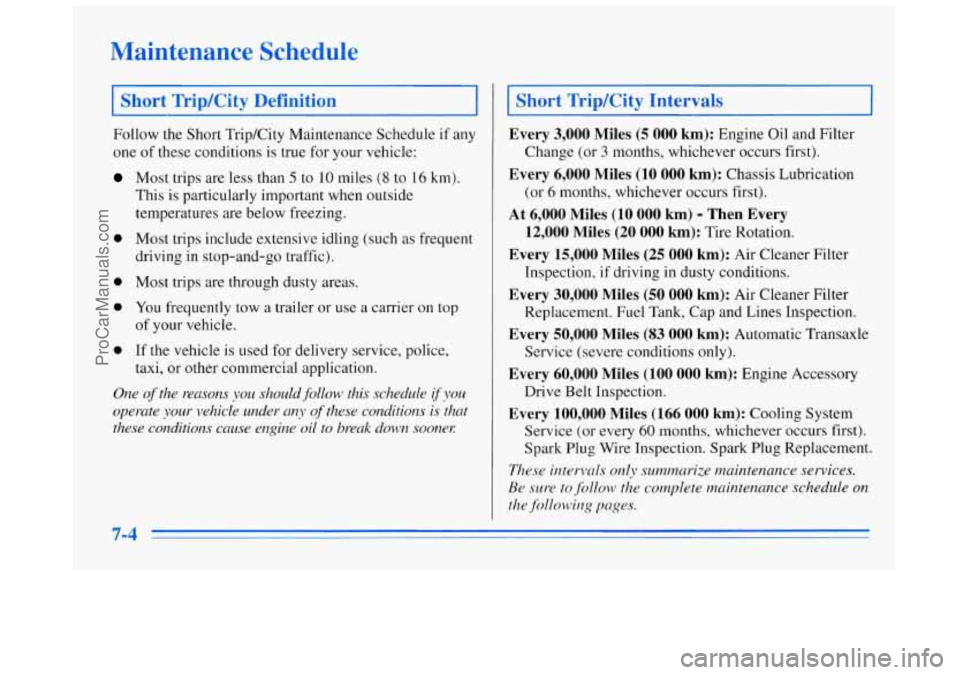
Maintenance Schedule
I Short Trip/City Defition I
Follow the Short Trip/City Maintenance Schedule if any
one
of these conditions is true for your vehicle:
Most trips are less than 5 to 10 miles (8 to 16 km).
This is particularly important when outside
temperatures
are below freezing.
0 Most trips include extensive idling (such as frequent
driving
in stop-and-go traffic).
0 Most trips are through dusty areas.
0 You frequently tow a trailer or use a carrier on top
of your vehicle.
0 If the vehicle is used for delivery service, police,
taxi, or other commercial application.
One of the reasons you should follow this schedule if you
operate your vehicle under any of these conditions is that
these conditions cause erzgirze oil to break down soonex
Short Trip/City Intervals
Every 3,000 Miles (5 000 km): Engine Oil and Filter
Change (or
3 months, whichever occurs first).
Every 6,000 Miles (10 000 km): Chassis Lubrication
(or
6 months, whichever occurs first).
At 6,000 Miles (10 000 km) - Then Every
12,000 Miles (20 000 km): Tire Rotation.
Every 15,000 Miles (25 000 km): Air Cleaner Filter
Inspection, if driving
in dusty conditions.
Every 30,000 Miles (50 000 km): Air Cleaner Filter
Replacement.
Fuel Tank, Cap and Lines Inspection.
Every 50,000 Miles (83 000 km): Automatic Transaxle
Service (severe conditions only).
Every 60,000 Miles (100 000 km): Engine Accessory
Drive Belt Inspection.
Every 100,000 Miles (166 000 km): Cooling System
Service (or every
60 months, whichever occurs first).
Spark Plug Wire Inspection. Spark Plug Replacement.
These ilztervnls on.ly summarize mainteuance services.
Be sure to follow th.e complete maintenance schedule on
the following pages.
7-4
ProCarManuals.com